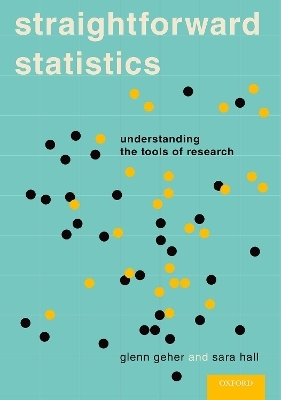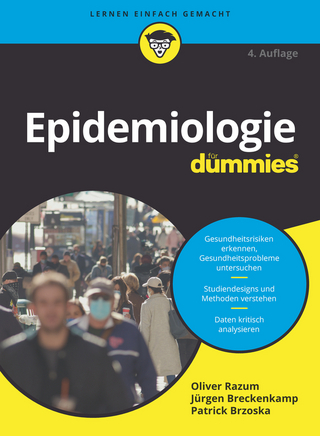
Straightforward Statistics
Oxford University Press Inc (Verlag)
978-0-19-975176-1 (ISBN)
Straightforward Statistics: Understanding the Tools of Research is a clear and direct introduction to statistics for the social, behavioral, and life sciences. Based on the author's extensive experience teaching undergraduate statistics, this book provides a narrative presentation of the core principles that provide the foundation for modern-day statistics. With step-by-step guidance on the nuts and bolts of computing these statistics, the book includes detailed tutorials how to use state-of-the-art software, SPSS, to compute the basic statistics employed in modern academic and applied research. Across 13 succinct chapters, this text presents statistics using a conceptual approach along with information on the relevance of the different tools in different contexts and summaries of current research examples.
Students should find this book easy useful and engaging in its presentation while instructors should find it detailed, comprehensive, accessible, and helpful in complementing a basic course in statistics.
Glenn Geher is Professor and Chair of Psychology at the State University of New York at New Paltz, where he has taught Statistics and various other courses related to psychology and evolution since 2000. He also is the founding director of New Paltz's Evolutionary Studies Program, which has been awarded thousands of dollars from the National Science Foundation to help advance evolution's place in higher education. He has over 60 publications including several books and articles on various topics related to evolution and social psychology. His work has been covered in several media outlets including the New York Times, Chronicle of Higher Education, Redbook, and Cosmopolitan. He lives with his wife Kathy and two children, Megan and Andrew, in rural upstate New York. Sara Hall has earned degrees in both Psychology and Criminology. She lives in Oregon with her husband, Benjamin, and their four children, Jackson, Stella, Susanna, and Sailor.
Preface ; 1: Why Do I Need to Learn Statistics? ; - Examples of statistics in the real world ; - The nature of findings and facts in the behavioral sciences ; - Descriptive and Inferential Statistics ; - A conceptual approach to teaching and learning statistics ; - What you should get out of this class ; 2. Describing a Single Variable ; - The nature of variables: continuous vs. categorical ; - Frequency distributions as descriptions of single variables ; - Creating frequency distributions ; - Representing frequency distributions graphically ; - Interpreting frequency distributions ; - Mean, median, and mode ; - Why is the mean the most-utilized index of central tendency? ; - The conceptual elements of standard deviation ; - Computing standard deviation ; 3. Standardized Scores ; - Why are standardized scores needed in the real world? ; - Why are standardized scores needed in statistics? ; - Computing Z scores ; - Interpreting Z scores ; - A real research example ; - Summary ; 4. Correlation ; - Real-world examples of correlations ; - Representing correlations graphically (the scatterplot) ; - Representing correlations quantitatively (Pearson's r: an index of correlation strength and direction) ; - Computing r using Z-scores ; - Interpreting r (what you can and cannot conclude knowing that a correlation between two variables exists) ; - A real research example ; - Summary ; 5. Statistical Prediction and Regression ; - The basic rationale underlying regression ; - Standardized model of bivariate regression ; - Raw-score model of bivariate regression ; - The regression line ; - Estimating error of prediction ; - Basic rationale underlying multiple regression ; - A real research example ; - Summary ; 6. The Basic Elements of Hypothesis Testing ; - Probability ; - The normal distribution ; - Estimating likelihood of outcomes ; - A real research example ; - Summary ; 7. Introduction to Hypothesis Testing ; - Basic rationale underlying hypothesis testing ; - What is meant by statistical significance? ; - The five steps of hypothesis testing: ; - Stating the null and research hypotheses ; - Delineating the nature of the comparison distribution ; - Determining alpha (by defining a part of the comparison distribution is highly unlikely) ; - Comparing a sample from the special population with the comparison distribution ; - Commenting on the null hypothesis ; - A real research example ; - Summary ; 8. Hypothesis Testing if N > 1 ; - The basic steps of hypothesis testing always remain the same ; - The comparison distribution needed for comparing a sample mean: The distribution of means ; - Hypothesis testing using the distribution of means ; - Confidence intervals ; - A real research example ; - Summary ; 9. Statistical Power ; - Defining Power (p(rejecting the null hypothesis when the research hypothesis is true) and Beta (p(Type-II error)) ; - How N, population-level standard deviation, and effect size affect power ; - Computing power ; - How power affects real research ; - A real research example ; - Summary ; 10. t-tests (One-Sample and Within-Groups) ; - How a t-test differs from a Z-test ; - The nature of the t-distribution (and why it varies as it does) ; - Computing a one-sample t-test ; - Computing a repeated-measures t-test ; - A real research example ; - Summary ; 11. t-tests: Between-Groups ; - The basic rationale of the between-groups t-test ; - Computing the between-groups t-test ; - Interpreting results ; - A real research example ; - Summary ; 12. Analysis of Variance ; - Basic reasoning of F as a ratio between effect and error variance ; - Concepts underlying a one-way ANOVA ; - Computing a one-way ANOVA ; - Factorial ANOVA ; - What results from an ANOVA can and cannot tell you ; - Post-hoc tests ; - A real research example ; - Summary ; 13. Chi-Square ; - What happens when all our variables are categorical? ; - Basic rationale underlying goodness of fit test ; - Computing the chi-square goodness of fit ; - Computing the chi-square test of independence ; - Interpreting chi-square results ; - A real research example ; - Summary ; Appendix A: Normal Curve (Z) Table ; Appendix B: t Table ; Appendix C: F Table ; Appendix D: Chi Square Table ; Appendix E: Advanced Statistics You May Run Into ; - Factor Analysis ; - Multiple regression ; - Structural Equation Modeling ; - Repeated-Measures ANOVA ; - Mixed-Design ANOVA ; - MANOVA ; Appendix F: Using SPSS to Compute Basic Statistics ; - Benefits of SPSS ; - Different kinds of SPSS files ; - Entering data with SPSS ; - Computing frequency distributions with SPSS ; - Describing variables with SPSS ; - Using SPSS to examine correlations ; - Using SPSS for a repeated-measures test ; - Using SPSS for a between-groups test ; - Using SPSS for a one-way ANOVA ; Glossary ; Answers to Set B Homework Problems ; References ; Index
| Verlagsort | New York |
|---|---|
| Sprache | englisch |
| Maße | 185 x 254 mm |
| Gewicht | 898 g |
| Themenwelt | Geisteswissenschaften ► Psychologie ► Sozialpsychologie |
| Mathematik / Informatik ► Mathematik ► Angewandte Mathematik | |
| Mathematik / Informatik ► Mathematik ► Statistik | |
| Studium ► Querschnittsbereiche ► Epidemiologie / Med. Biometrie | |
| ISBN-10 | 0-19-975176-5 / 0199751765 |
| ISBN-13 | 978-0-19-975176-1 / 9780199751761 |
| Zustand | Neuware |
| Informationen gemäß Produktsicherheitsverordnung (GPSR) | |
| Haben Sie eine Frage zum Produkt? |
aus dem Bereich


